■ Fender Stratocaster 1967 Model
Fifty-five years ago, Fender’s production of the Stratocaster hit its lowest point, leading to rumors that it might even be discontinued. However,this year brought the introduction of an optional "maple cap fretboard." This fretboard was manufactured using nearly the same process as the rosewood fretboards of the time, though the option itself would be discontinued around 1971.
The maple cap fretboard contributed a bold, focused, and raw tone, likely due to the unique interplay between the maple fretboard and the single-coil pickups. This interaction, along with the thin maple neck, produced a bright and articulate sound with a hint of crunch and a treble bite. This guitar could shine in sessions, standing out in sound even when playing alongside others.
This 1967 Stratocaster is a perfect fit for rugged, masculine rock and guitar-driven hard rock. It can produce bold, unrestrained tones, but depending on the player's technique, it’s also surprisingly delicate and expressive. Its sound has a clear, solid identity, effortlessly channeling the bite of Jimi Hendrix’s treble-rich tone or the direct, full-force squeeze of Stevie Ray Vaughan’s riffs. This Strat responds dynamically to distortion, making it an ideal partner for players who push its limits, yielding a priceless, personalized experience for those who resonate with its tone.
Given the natural wood used, there’s always variation from guitar to guitar, yet it’s remarkably easy to find a true “winner” from this era. While Hendrix epitomizes the iconic '67 Stratocaster player, YJM's performances with a similarly spec’d Strat also leave a lasting impression. With its maple cap gleaming under stage lights and proudly showing its battle scars, it’s truly a rock guitarist’s treasure. As they say, nothing compares to an authentic "MADE IN USA" Strat—experience it once, and you'll understand why.
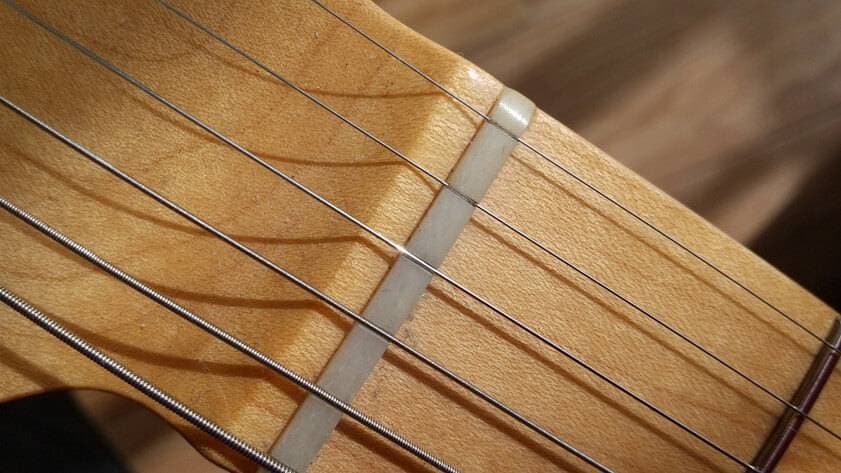

[Maple Cap Fretboard]
Photographing the maple cap fretboard was challenging, but from the side view, you can clearly see the fret tang aligning with the maple cap’s thickness. The join between the maple cap fretboard and the neck is especially visible near the right side of the fret dots, showing the layered construction. If you find one with this clarity in craftsmanship, it might just be a “buy” worth considering!
○ Neck
When Fender initially introduced the large headstock on the Stratocaster, it was met with a mixed reception—many felt it lacked the refined look of earlier models. However, for guitarists who started using Strats from the mid-1970s onward, the large headstock probably felt like a natural fit, as it was all they’d known. I’m one of those players, too. But one has to wonder how the players who came of age in the '50s through the early '70s viewed this design shift.
In my last review, I included a photo of the tremolo-equipped Telecaster Deluxe, which also features a large headstock. That model goes even further in terms of power, packing two of Fender’s most robust humbuckers and a heavy-duty tremolo unit, making it a competitive answer to Gibson's market influence at the time. However, this aggressive approach may have been a bit much for Fender’s audience, as the Telecaster Deluxe was eventually discontinued in 1981.
One notable quirk with the large headstock Stratocasters is their decal differences, especially around the patent numbers. U.S.-made Strats have two patent numbers marked on the headstock, but Fender Japan models with large headstocks lack these numbers entirely! Players familiar with this detail sometimes feel that the Japanese headstocks seem unfinished or incomplete by comparison.
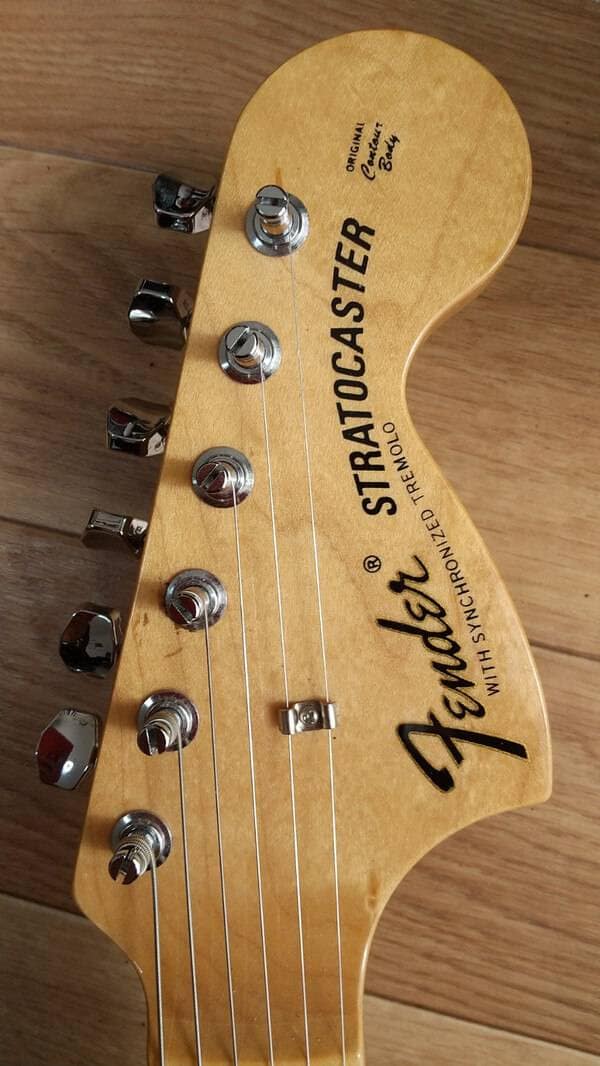
[Japanese Large Headstock]
The U.S.-made large headstock Stratocasters feature two patent numbers on the decal, while the Japanese-made versions have neither.
Since these patent numbers can’t appear on the Japanese models, it does feel somewhat incomplete—like a bowl of ramen without pepper. For reference, the two U.S. patent numbers are 2,741,146 and 3,143,028, covering the synchronized tremolo and the adjustable neck, respectively.
The “FENDER” logo on both Japanese and American models remains in the transition style. Around this time, Kluson tuners were discontinued, replaced by tuners developed in collaboration with Race & Olmsted starting in 1968. This new design, known as the "F-Key" tuners (see peg photo), was developed with input from Forrest White on Fender’s side.
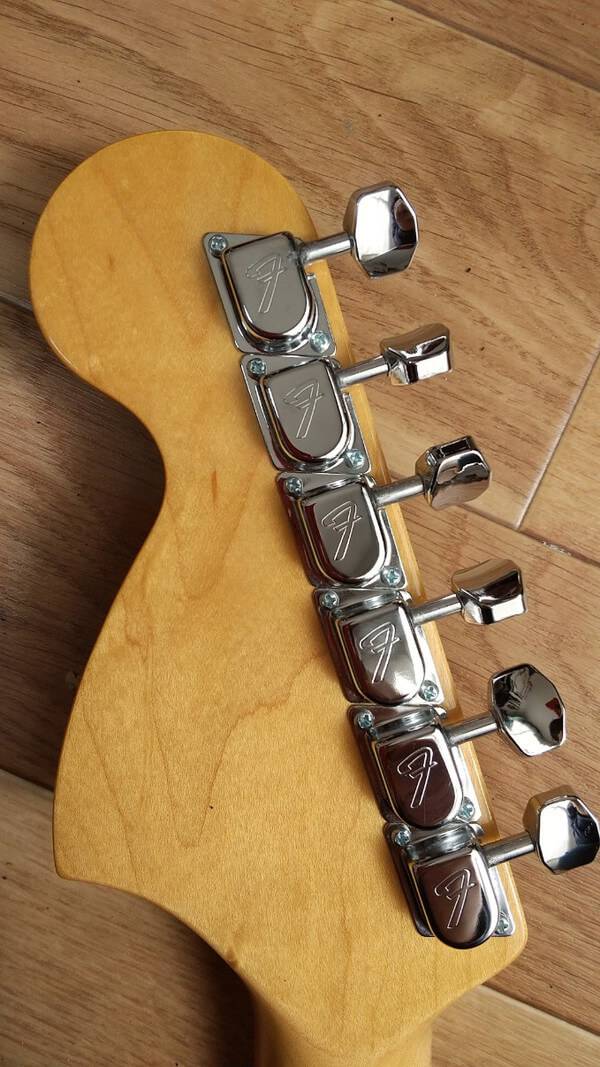
[F-Key Tuners]
When tuning, the F-Key tuners can feel slightly less precise or secure—possibly because I'm more accustomed to Kluson tuners.
Interestingly, the Race & Olmsted factory was located just behind Fender’s own facility, making it a go-to for Leo Fender. This proximity likely allowed Leo’s ideas to quickly be tested and prototyped, which also meant Race & Olmsted faced high expectations for quality from Leo.
Initially, these string winders were a joint production between Fender and Race & Olmsted. Later, the F-Keys were upgraded with versions made by Schaller in West Germany.
Other details include a single string guide and pearloid dot inlays on the neck. These glossy pearloid dots have a more polished look compared to the matte, clay-colored inlays used on previous models.
○ Body & Pickguard
The pickguard is an 11-screw, three-ply PVC construction. Unlike the earlier "green guard" models that aged to a mint-green tint over time, this one remains primarily a non-fading white.
○ Tremolo Arm
In the late '60s, many Stratocaster tremolo arms were either straight or had only a slight bend, making it harder to comfortably hold in the palm and control subtle vibrato. Jeff Beck, for instance, uses a shorter arm with a more pronounced angle, allowing for nuanced pitch modulation even while keeping it within his right hand—a setup that delivers expressive, precise vibrato. Interestingly, it’s said he could pick up chopsticks instantly in Japan, hinting at his knack for modifications—whether for guitars or cars.
As for the internal components, CBS-era Fender purchased parts like capacitors in bulk without much attention to quality or specifications. This included inexpensive red ceramic capacitors and yellow insulation tubing, indicating a less meticulous approach compared to earlier Fender standards.
■ Fender Stratocaster 1968 Model
○ Neck
In 1968, the Fender large headstock featured black lettering outlined in gold, replacing the more understated gold lettering used since 1966. This bold design, known as the “CBS logo,” stood out more and remained in use until 1971.
I own a Stratocaster with the large headstock and F-Key tuners. Compared to the heavier Rotomatic tuners, the F-Keys are lighter but have a somewhat stiff feel—not particularly smooth, and a bit less sturdy. However, their fine gear mesh allows for precise tuning adjustments.
Interestingly, Fender used plastic nut materials even on Custom Shop models, a fact that isn’t widely known. I verified this myself with my own Strat, a model from the 2000s.
○ Serial Number
The neck stamps on Stratocaster models shifted to a numbering system between 13 and 22. For instance, a stamp like "22SEP68" would indicate a "Stratocaster, September 1968, standard width neck." This format allows for easy identification of the model, production month, year, and neck specifications.
○ Body
The body contouring on the 1968 Stratocaster is very shallow—about two-thirds of the carving depth seen on '50s models, making it almost unnoticeable. The finish reflects the mass production of the CBS era, giving it a glossier, more plastic-like sheen, which can feel a bit less refined by today’s standards.
While the original lacquer finish on vintage models ages gracefully, showing tasteful wear and scratches as character, many modern guitars are now intentionally “relic’d” to achieve a worn look. These meticulously aged finishes require additional labor, which raises their price, feeding a trend that prefers heavily worn guitars—even when brand new. Although preferences vary, this trend has impacted the vintage market, as worn-looking instruments have become fashionable.
For those unfamiliar with electric guitars, the vibrant colors can be surprising. It’s common, especially among girls, to hear, "Wait, is this really made of wood?"
○ Electronics
True to Fender’s approach, they repurposed the reverse side of Mustang pickguards for the Stratocaster’s 1968 electronics. This pickguard consists of a three-ply construction: white PVC on top, black PVC in the middle, and a pearl white celluloid bottom layer originally used for Mustangs.
Previously, Fender would apply full shielding on the back of pickguards to reduce noise, but in 1968, shielding was limited to the smaller control area. This shift likely stemmed from the challenges of scaling up production as Fender expanded its model lineup, making it harder to keep up with detailed shielding processes.
The late '60s in the United States was also a turbulent time politically, casting a darker mood over the era. Yet in 1969, the Stratocaster saw a remarkable comeback, bursting back into popularity and finally emerging from a difficult period.
Stay tuned for that exciting revival! ♪
The “sound & person” column is made up of contributions from you.
For details about contributing, click here.











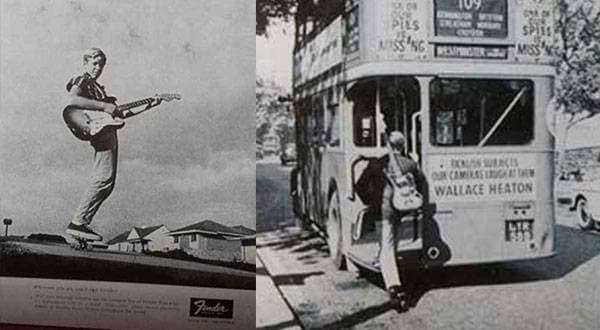
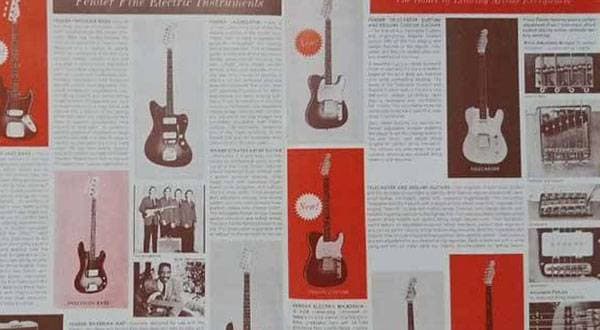
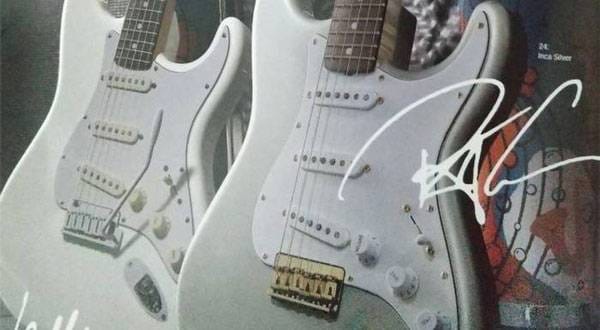
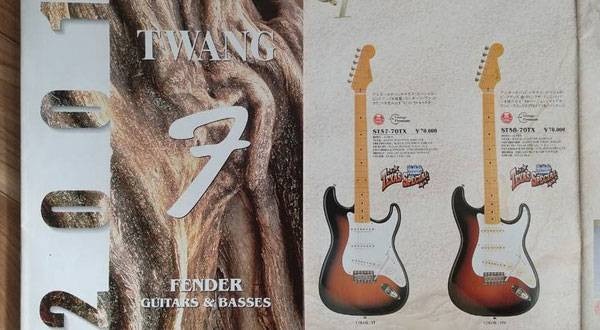
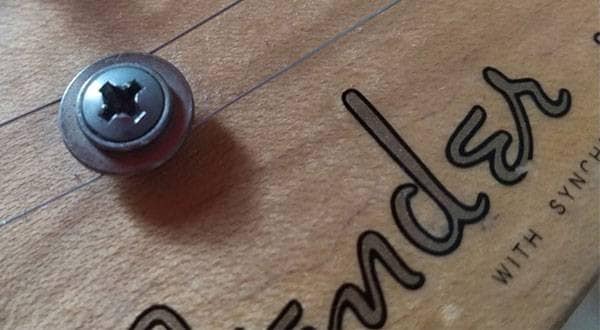
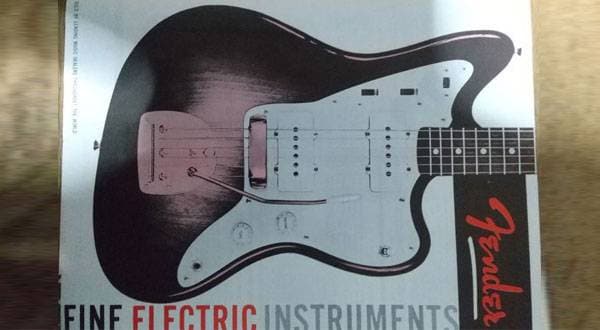
 Fender プロダクトラインナップ
Fender プロダクトラインナップ
 FENDER(フェンダー)ブランドサイト
FENDER(フェンダー)ブランドサイト
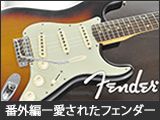 愛されたフェンダーギターたち
愛されたフェンダーギターたち
 ギターの種類
ギターの種類
 ギター名人ラボ
ギター名人ラボ
 ギタースタートガイド
ギタースタートガイド















